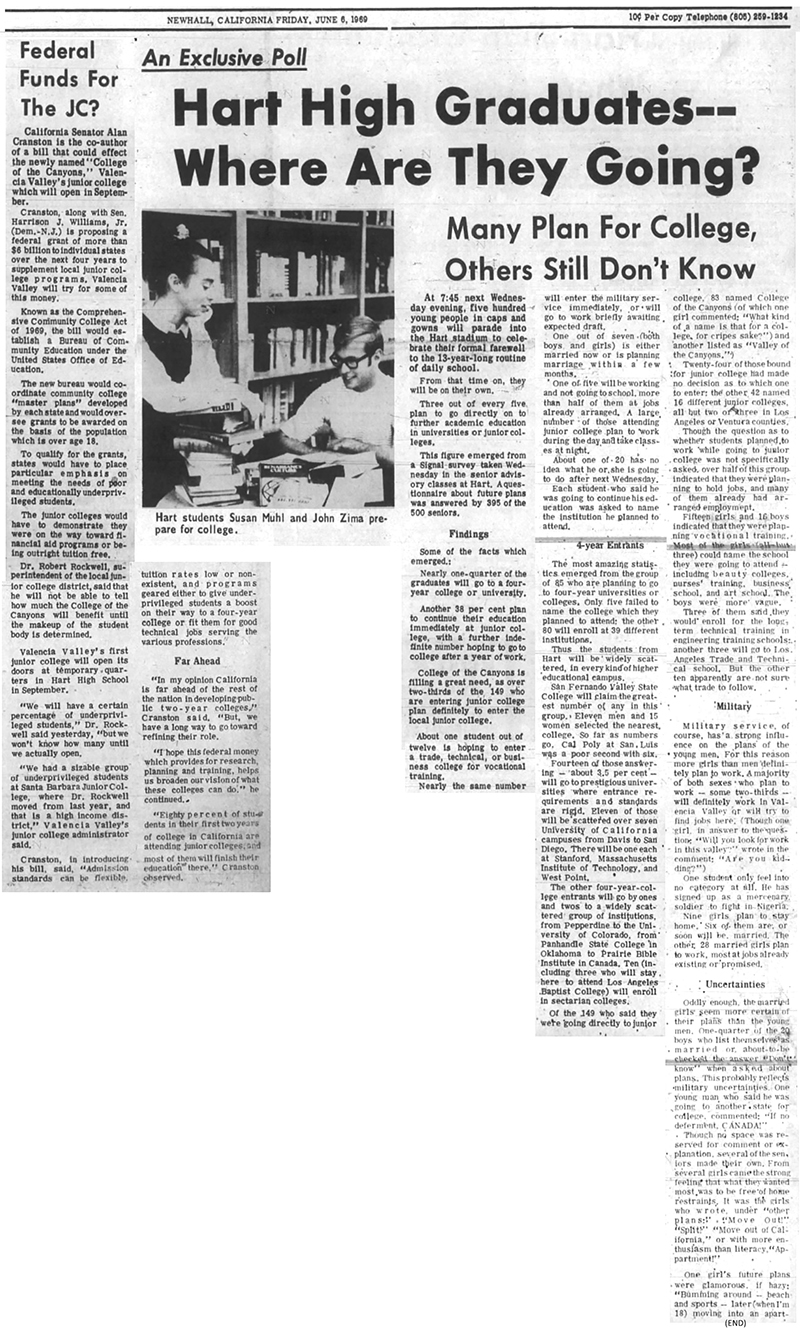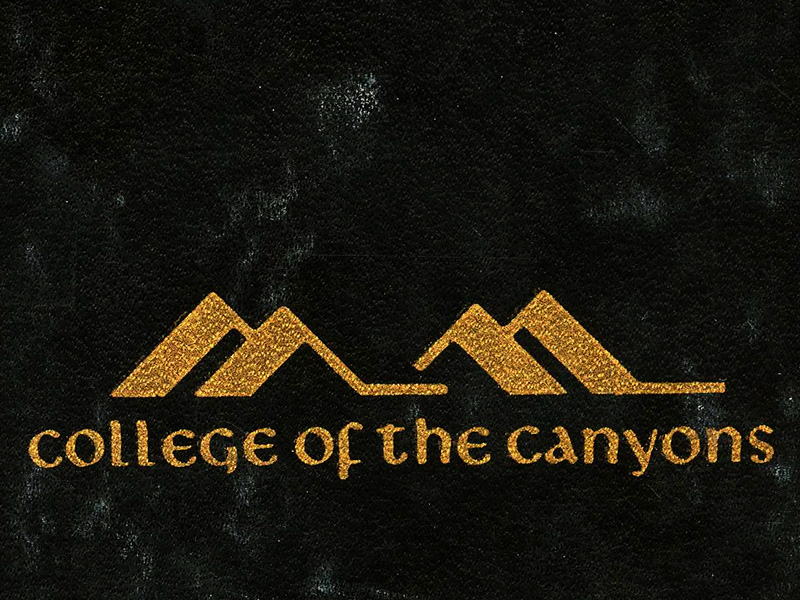Hart High Graduates — Where Are They Going?
Many Plan for College, Others Still Don't Know.
The Signal | Friday, June 6, 1969.
At 7:45 next Wednesday evening, five hundred young people in caps and gowns will parade into the Hart stadium to celebrate their formal farewell to the 13-year-long routine of dally school.
From that time on, they will be on their own.
Three out of every five plan to go directly on to further academic education in universities or junior colleges.
This figure emerged from a Signal survey taken Wednesday in the senior advisory classes at Hart. A questionnaire about future plane was answered by 395 of the 500 seniors.
Some of the facts which emerged:
Nearly one-quarter of the graduates will go to a four-year college or university.
Another 38 per cent plan to continue their education immediately at junior college, with a further indefinite number hoping to go to college after a year of work.
College of the Canyons is filling a great need, as over two-thirds of the 149 who are entering junior college plan definitely to enter the local junior college.
About one student out of twelve is hoping to enter a trade, technical, or business college for vocational training.
Nearly the same number will enter the military service immediately, or will go to work briefly awaiting expected draft.
One out of seven (both boys and girls) is either married now or is planning marriage within a few months.
One of five will be working and not going to school, more than half of them at jobs already arranged. A large number of those attending junior college plan to work during the day and take classes at night.
About one of 20 has no idea what he or she is going to do after next Wednesday.
Each student who said he was going to continue his education was asked to name the institution he planned to attend.
The most amazing statistics emerged from the group of 85 who are planning to go to four-year universities or colleges. Only five failed to name the college which they planned to attend; the other 80 will enroll at 39 different institutions.
Thus, the students from Hart will be widely scattered in every kind of higher educational campus.
San Fernando Valley State College will claim the greatest number of any in this group. Eleven men and 15 women selected the nearest college. So far as numbers go, Cal Poly at San Luis was a poor second with six.
Fourteen of those answering — about 3.5 per cent — will go to prestigious universities where entrance requirements and standards are rigid. Eleven of those will be scattered over seven University of California campuses from Davis to San Diego. There will be one each at Stanford, Massachusetts Institute of Technology, and West Point.
The other four-year-college entrants will go by ones and twos to a widely scattered group of institutions, from Pepperdine to the University of Colorado, from Panhandle State College in Oklahoma to Prairie Bible Institute in Canada. Ten (including three who will stay here to attend Los Angeles Baptist College) will enroll in sectarian colleges.
Of the 149 who said they were going directly to junior college, 83 named College of the Canyons (of which one girl commented: "What kind of a name is that for a college, for cripes sake?") and another listed as "Valley of the Canyons."
Twenty-four of those hound for junior college had made no decision as to which one to enter; the other 42 named 16 different junior colleges, all but two or three in Los Angeles or Ventura counties.
Though the question as to whether students planned to work while going to junior college was not specifically asked, over half of this group indicated that they were planning to hold jobs, and many of them already had arranged employment.
Fifteen girls and 16 boys indicated that they were planning vocational training. Most of the girls (all but three) could name the school they were going to attend — including beauty colleges, nurses' training, business school, and art school. The boys were more vague.
Three of them said they would enroll for the long-term technical training in engineering training schools; another three will go to Los Angeles Trade and Technical school. But the other ten apparently are not sure what trade to follow.
Military service, of course, has a strong influence on the plans of the young men. For this reason more girls than men definitely plan to work. A majority of both sexes who plan to work — some two-thirds — will definitely work in Valencia Valley or will try to find jobs here. (Though one girl, in answer to the question: "Will you look for work in this valley?" wrote in the comment: "Are you kidding?")
One student only fell into no category at all. He has signed up as mercenary soldier to fight in Nigeria.
Nine girls plan to stay home. Six of them are, or soon will be, married. The other 28 married girls plan to work, most at jobs already existing or promised.
Oddly enough, the married girls seem more certain of their plans than the young men. One-quarter of the 20 boys who list themselves as married or about-to-be checked the answer "Don't know" when asked about plans. This probably reflects military uncertainties. One young man who said he was going to another state for college commented, "If no deferment, CANADA!"
Though no space was reserved for comment or explanation, several of the seniors made their own. From several girls came the strong feeling that what they wanted most was to be free of home restraints. It was the girls who wrote, under "other plans," "Move Out!" 'Split!" "Move out of California," or with more enthusiasm than literacy, "Appartment!"
One girl's future plans were glamorous, if hazy: "Bumming around — beach and sports — later (when I'm 18) moving into an apart- [layout error; story ends here].
Federal Funds for the JC?
The Signal | Friday, June 6, 1969.
California Senator Alan Cranston is the co-author of a bill that could affect the newly named "College of the Canyons," Valencia Valley's junior college which will open in September.
Cranston, along with Sen. Harrison J. Williams Jr. (Dem.-N.J.) is proposing a federal grant of more than $6 billion to individual states over the next four years to supplement local junior college programs. Valencia Valley will try for some of this money.
Known as the Comprehensive Community College Act of 1969, the bill would establish a Bureau of Community Education under the United States Office of Education.
The new bureau would coordinate community college "master plans" developed by each state and would oversee grants to be awarded on the basis of the population which is over age 18.
To qualify for the grants, states would have to place particular emphasis on meeting the needs of poor and educationally underprivileged students.
The junior colleges would have to demonstrate they were on the way toward financial aid programs or being outright tuition free.
Dr. Robert Rockwell, superintendent of the local junior college district, said that he will not be able to tell how much the College of the Canyons will benefit until the makeup of the student body is determined.
Valencia valley's first junior college will open its doors at temporary quarters in Hart High School in September.
"We will have a certain percentage of underprivileged students," Dr. Rockwell said yesterday, "but we won't know how many until we actually open.
"We had a sizable group of underprivileged students at Santa Barbara Junior College," where Dr. Rockwell moved from last year, and "that is a high-income district," Valencia Valley's junior college administrator said.
Cranston, in introducing his bill, said, "Admission standards can be flexible, tuition rates low or nonexistent, and programs geared either to give underprivileged students a boost on their way to a four-year college or fit them for good technical jobs serving the various professions.
"In my opinion, California is far ahead of the rest of the nation in developing public two-year colleges," Cranston said. "But, we have a long way to go toward refining their role.
"I hope this federal money which provides for research, planning and training, helps us broaden our vision of what these colleges can do," he continued.
"Eighty percent of students in their first two years of college in California are attending junior colleges, and most of them will finish their education there," Cranston observed.
Webmaster's note: The "Comprehensive Community College Act of 1969" never got out of committee. Sen. Williams reintroduced it in 1971, again to no avail, although the Nixon administration's U.S. Office of Education created the position of Director of Community College Education during this period. In 1972, a sweeping higher-education spending bill fizzled and morphed into Title IX, which prohibited gender discrimination in educational programs that receive federal funding. Significant federal assistance for community colleges finally came in 1978, during the Carter administration, in the form of direct payments to students via an expansion of eligibility for Pell and other grants.
| 
























